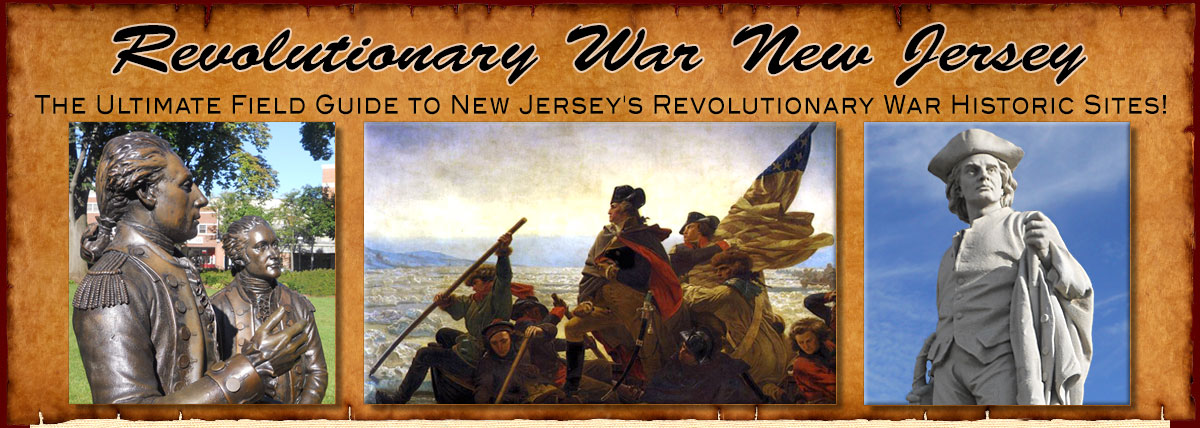

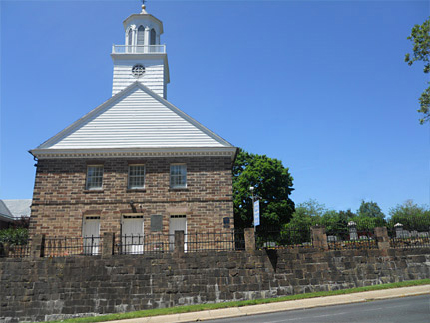
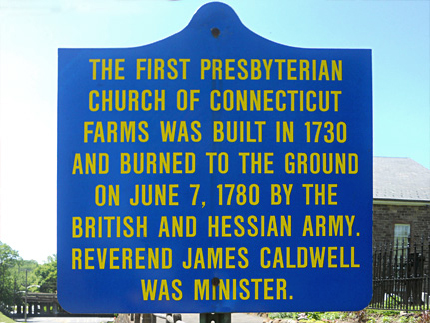
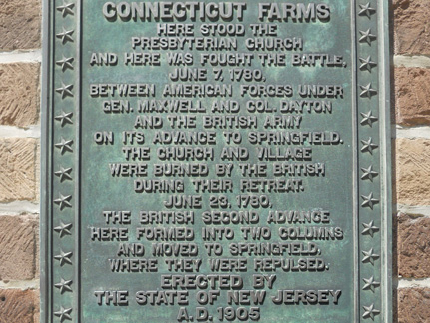
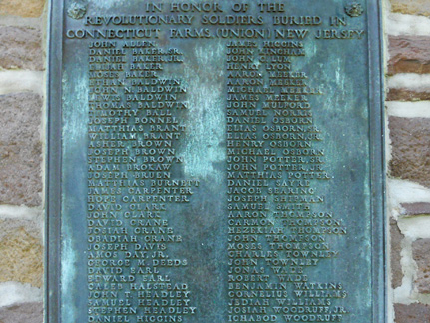
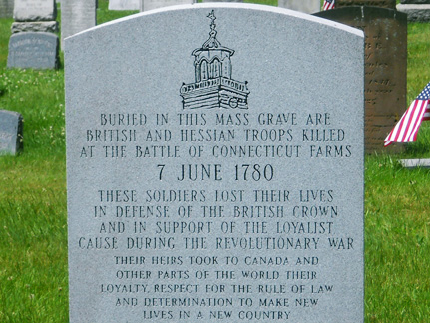
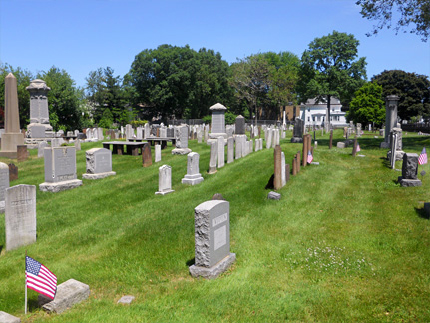
Connecticut Farms Presbyterian Church and Cemetery
888 Stuyvesant Ave.
Map / Directions to Connecticut Farms Presbyterian Church and Cemetery
Map / Directions to all Union NJ Revolutionary War Sites
The Battle of Connecticut Farms, June 7, 1780
The area that today makes up Union Township was known as Connecticut Farms during the Revolutionary War era. (It became Union in 1808.) [1] An important battle took place in Connecticut Farms on June 7, 1780.
In June of 1780, Washington and his army were encamped at Morristown where they had been throughout the brutal winter of 1779/1780. The winter had been the worst of the century. There were twenty-eight snowstorms, and temperatures were so continuously cold that for the only time in recorded history, the waters around New York City froze over and were closed to shipping for weeks at a time. [2] In the midst of these extreme weather conditions, the soldiers had to build their own huts and endure a serious shortage of food. The number of Washington's troops had dwindled, and the army's weapons and supplies were not sufficiently protected. The weather and lack of food over the winter had also cost the army most of their horses, which would hinder their ability to move their supplies to safety.
Two attempts were made in June 1780 by British and Hessian forces to invade New Jersey, attack Washington's troops at Morristown, and seize the vulnerable supplies. (Hessians were German mercenary troops hired by the British to fight with them against the Americans in the Revolutionary War.) Beginning with landing troops from Staten Island at Elizabethtown, they planned to move west through a gap in the Watchung Mountains with the intent to attack Washington at Morristown.
It can be hard for us living in the 21st century to visualize the importance of the Watchung Mountains during the Revolutionary War. Over two centuries of development and highway building have changed the visible landscape, and these changes allow us to easily drive over mountains which were once major obstacles to transportation and movement. For Washington's troops encamped at Morristown, the three ridges of the Watchung Mountains provided layers of protection that stretched for over 40 miles from Mahwah to Somerset County.
A gap in the Watchung Mountains known as Hobart Gap provided the one easy route to Washington's troops at Morristown. Hobart Gap was the last militarily defensible position between Elizabeth and Morristown; if the British troops could make it past Hobart Gap, they would have an easy path to Morristown to capture Washington's arms and supplies. Today, Route 24 passes through Hobart Gap in the Watchung Mountains, as does Morris Ave. in Springfield, and Millburn Ave. in Millburn. Modern development and work on the highway, including raising the elevation of this part of the highway with landfill, make it hard for our modern eyes to envision Hobart Gap as it was in the 1700's, but its legacy endures in the name of Hobart Gap Road in Summit, which passes over Rt 24.
The first attempt to invade and move through Hobart Gap began when British and Hessian troops landed at Elizabethtown on June 6, 1780. The following day, the invading force of 5000 British and Hessian troops under the command of Hessian Lieutenant General Wilhelm von Knyphausen made it as far as the village of Connecticut Farms where they fought Continental Army and New Jersey Militia forces under the command of General William Maxwell, in what is known as the Battle of Connecticut Farms.
As British and Hessian troops fought their way through Connecticut Farms, some of the heaviest fighting took place around the area of the Presbyterian Church. The church building that stands here today is not the original church at this location. The original church building was burned that day along with much of the Village of Connecticut Farms by British/Hessian forces.
Although General Knyphausen's forces captured Connecticut Farms for several hours that day, he decided that evening to withdraw, and the British and Hessian forces returned to Elizabethtown. They left a devastated village behind them, having burned much of the Connecticut Farms. Sixteen days later, on June 23, 1780, they would make their way back through Connecticut Farms and on to Springfield and what became the Battle of Springfield. [3]
The cemetery at the Connecticut Farms Presbyterian Church contains the graves of seventy-two known American Revolutionary War soldiers: [4]
John Allen
Daniel Baker, Sr.
Daniel Baker, Jr.
Elijah Baker
Moses Baker
Ethan Baldwin
John N. Baldwin
Lewis Baldwin
Thomas Baldwin
Timothy Ball
Joseph Bonnel
Matthias Brant
William Brant
Asher Brown
Joseph Brown
Stephen Brown
Adam Brokaw
Joseph Bruen
Matthias Burnett
James Carpenter
Hope Carpenter
David Clark
John Clark
David Crane
Josiah Crane
Obadiah Crane
Joseph Davis
Amos Day, Jr.
George M. Deeds
David Earl
Edward Earl
Caleb Halstead
John T. Headley
Samuel Headley
Stephen Headley
Daniel Higgins
James Higgins
John Kingham
John C. Lum
Henry Lyon
Aaron Meeker
Aaron Meeker (a different person)
Michael Meeker
James Meeker
John Mulford
Samuel Norris
Daniel Osborn
Elias Osborn, Sr.
Elias Osborn, Jr.
Henry Osborn
Michael Osborn
John Potter, Sr
John Potter, Jr
Matthias Potter
Daniel Sayre
Jacob Searing
Joseph Shipman
Samuel Smith
Aaron Thompson
Carmon Thompson
Hezekiah Thompson
John Thompson
Moses Thompson
Charles Townley
John Townley
Jonas Wade
Robert Wade
Benjamin Watkins
Cornelius Williams
Jediah Williams
Josiah Woodruff, Jr.
Ichabod Woodruff
The cemetery also contains a mass grave of British and Hessian soldiers who died at the Battle of Connecticut Farms. A gravestone was erected in 2001 to pay tribute to these unknown British and Hessian soldiers: "Buried in this mass grave are British and Hessian Troops killed at the Battle of Connecticut Farms June 7, 1780. These soldiers lost their lives in defense of the British Crown and in support of the Loyalist cause during the Revolutionary War. Their heirs took to Canada and other parts of the world their loyalty respect for the rule of law and determination to make new lives in a new country." [5]

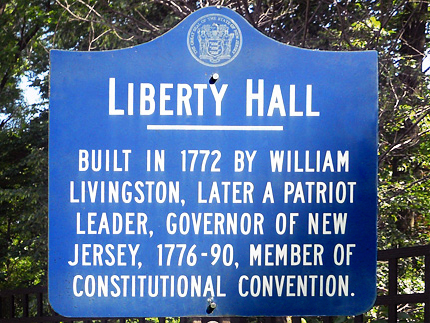
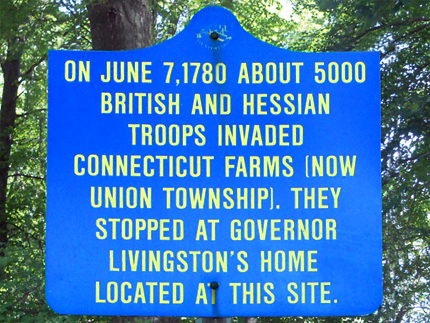
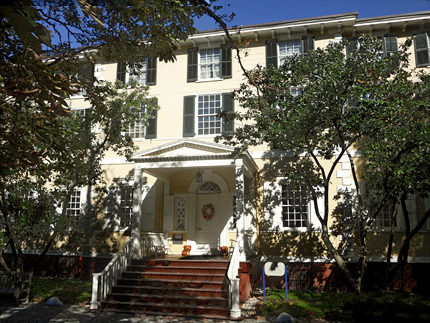
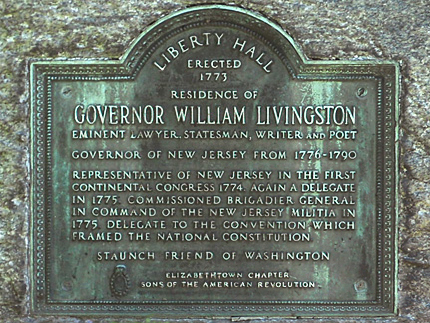
Liberty Hall Museum
1003 Morris Ave. (At Kean University)
Map / Directions to Liberty Hall
Map / Directions to all Union NJ Revolutionary War Sites
For current hours and admission information, see the Liberty Hall Museum Website
Liberty Hall was the home of New Jersey Governor William Livingston during the Revolutionary War. On the morning of June 7, 1780, British and Hessian troops made their way from Elizabethtown towards Connecticut Farms to what would become the Battle of Connecticut Farms. Around 6 a.m., troops under Hessian Colonel Ludwig von Wurmb stopped at Liberty Hall, hoping to capture Governor Livingston. Livingston was not at the house. Instead, von Wurmb was met by Livingston's daughter Susan standing in front. Susan charmed von Wurmb, and von Wurmb assured Susan that the house would not be burned. He even posted a guard at the gate of the house to assure that no other passing soldier would disturb her or the house. Unfortunately, other houses and the church in Connecticut Farms would not be so lucky to escape burning in the battle that followed that day. (See the Connecticut Farms Presbyterian Church entry above and the Caldwell Parsonage entry below.)
Sixteen days later, a similar scene was repeated here when British Lieutenant Colonel Cosmo Gordon met Susan and her sister Kitty at Liberty Hall on the path to Springfield and what would become the Battle of Springfield. Once again Susan appealed to the enemy officer to not burn the house; once again she charmed the enemy officer into agreeing not to disturb the house. And as with the village of Connecticut Farms, the residents of Springfield were not so lucky as the Livingstons. All but four of the houses in Springfield were burned at the Battle of Springfield. [6]
William Livingston was elected Governor in 1776. He was the first elected Governor of New Jersey; all previous New Jersey governors had been Royal Governors, appointed by the king of England before American Independence was declared. (The last of the Royal Governors was William Franklin, the son of Benjamin Franklin.)
In addition to Livingston's service as governor, he also served as a delegate to the First and Second Continental Congress from 1774 to1776. In 1775 he was commissioned a brigadier general of the New Jersey militia. He remained as New Jersey Governor and continued to live at Liberty Hall until his death in 1790. In 1787, while still governor, he attended the Constitutional Convention. He was one of four signers of the United States Constitution for New Jersey. The other three New Jersey signers were:
• David Brearly (Buried at St. Michael's Episcopal Church in Trenton)
• Jonathan Dayton (Lived at Boxwood Hall in Elizabeth, and buried at St. John's Episcopal Cemetery in Elizabeth)
• William Paterson (Paterson is named in his honor)
Liberty Hall was built in 1772. Among the Revolutionary War luminaries who were guests at the house were George and Martha Washington, and Alexander Hamilton. [7] Liberty Hall was Livingston's main residence, but he also leased a house in Parsippany that he used during the Revolutionary War at times when British troop locations made Liberty Hall unsafe.

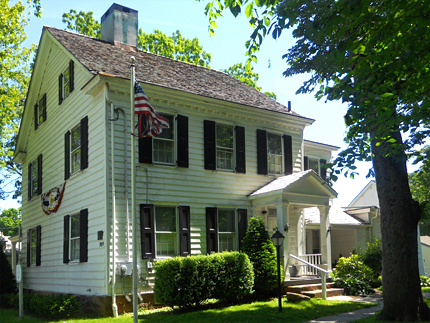
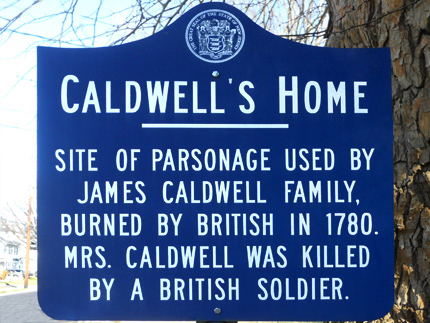
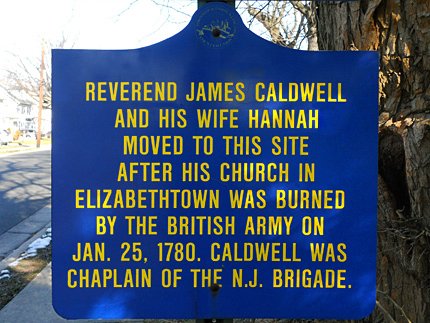
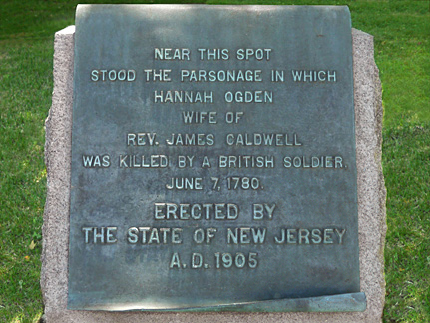
Caldwell Parsonage
909 Caldwell Ave.
Map / Directions to the James Caldwell House
Map / Directions to all Union NJ Revolutionary War Sites
For current hours and admission information, see the Union Township Historical Society Website
This is the site of a parsonage used by Reverend James Caldwell in 1780. Caldwell had an interesting Revolutionary War history, with connections to a number of historic sites throughout Union and Essex County. He was instrumental in forming the Presbyterian Church in Caldwell, and the town of Caldwell was named for him. He was pastor of the First Presbyterian Church in Elizabeth, which was burned by British troops on January 25, 1780, along with his home.
After their house in Elizabeth was burned, James, his wife Hannah, and their nine children moved to a parsonage (built 1730) at this site. Sadly, Hannah was killed here when she was struck by a bullet fired through a window by a British soldier during the Battle of Connecticut Farms on June 7, 1780. Her death was most likely due to a British soldier mistaking her to be a sniper at the window. The British and Hessian troops burned many of the houses in Connecticut Farms that day, including the Caldwell Parsonage. [8] The house was rebuilt in 1782 on the stone foundation of the original house. That 1782 house stands here today. [9]
Sixteen days later after the Battle of Connecticut Farms, James took part in the fighting at the Battle of Springfield, and is known for his for his call to "Give 'em Watts, Boys!". Just a year and a half after Hannah's death, James Caldwell himself was killed on November 24, 1781 by an American sentry named James Morgan. Morgan was tried at the Presbyterian Church in Westfield, found guilty, and then hanged at Gallows Hill in Westfield. Both James and Hannah are buried in the Elizabeth First Presbyterian Church Cemetery. [10]
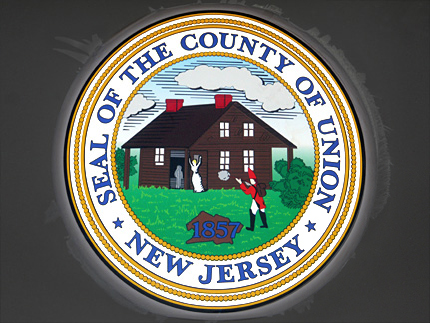
The death of Hannah Caldwell at the Parsonage is depicted on the Seal of Union County. The image on the seal takes liberties with the story, as it shows a British soldier deliberately gunning down Hannah Caldwell standing outside of the house, when in reality she was shot through a window by a soldier who probably mistook her to be a sniper.
This may be the only town, county, or state seal in the United States that depicts a killing. [11]
The photo at left shows the seal as it appears over the entrance to the Union County courthouse in Elizabeth.

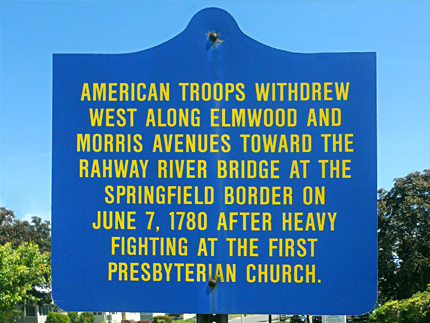
Caldwell Ave. near the corner of Elmwood Ave.
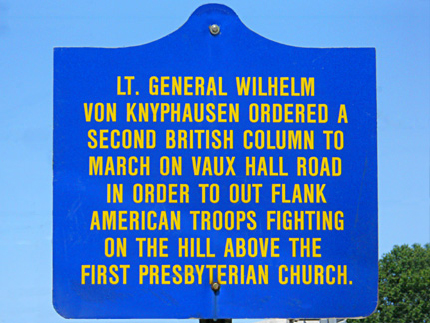
Vauxhall Rd. near the corner of Stuyvesant Ave.
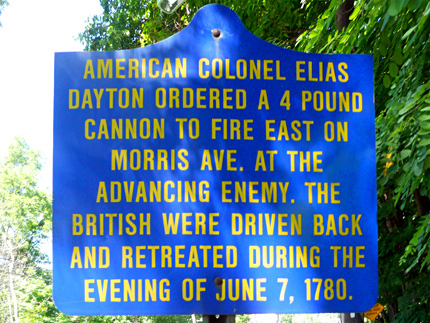
Morris Ave. near Spruce St., on the Union side of the Rahway Bridge
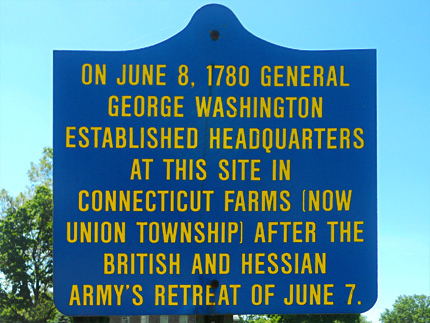
Stuyvesant Ave. Near Elmwood Ave., near Connecticut Farms Church
Battle of Connecticut Farms Historic Signs
• Vauxhall Rd. Near the Corner of Stuyvesant Ave.
• Caldwell Ave. Near the Corner of Elmwood Ave.
• Morris Ave. near Spruce St., on the Union side of the Rahway Bridge
• Stuyvesant Ave. Near Elmwood Ave., near Connecticut Farms Church
Click here for Map / Directions for these 4 signs
Map / Directions to all Union NJ Revolutionary War Sites
In addition to the other Union historic signs shown in the above entries, there are these four signs which give specific details of events on June 7 and 8, 1780, related to the Battle of Connecticut Farms. Each sign is located where the events described in the sign occurred.

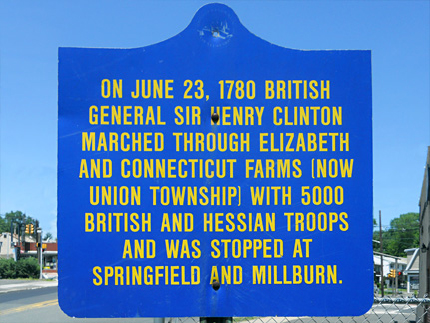
March to Battle of Springfield Historic Sign
Vauxhall Rd. Near the Corner of Burnet Ave.
Map / Directions for this sign
Map / Directions to all Union NJ Revolutionary War Sites
Sixteen days after the Battle of Connecticut Farms, another attempt was made by British and Hessian forces to make it through Hobart Gap and attack Washington's forces at Morristown.
On June 23, 1780, 5000 British and Hessian troops under General Henry Clinton passed though Connecticut Farms, which had been burned only sixteen days before, and made it as far as Springfield, where they were defeated at the Battle of Springfield.
For more details about the Battle of Springfield, see the Springfield page.

1. ^ At the time of the Revolutionary War, the village of Connecticut Farms was part of the Elizabethtown Tract. Elizabethtown originally made up all of what is now Union County. (See the Elizabeth page).
• On November 23, 1808, the New Jersey Legislature passed an act creating the Township of Union. The text of the act can be read in:
Joseph Bloomfield, compiler, Laws of the State of New Jersey (Trenton: James J. Wilson, 1811) p. 199- 202
Available to be read at Google Books here.
(Note that the act describes the geographic area that will make up Union Township, but does not use the term "Connecticut Farms")
• Later adjustments to the size and boundaries of Union Township were made between 1834 - 1920. Details can be found in:
John F. Snyder, The Story of New Jersey's Civil Boundaries: 1606-1968 (Trenton: Bureau of Geology and Topography, 1969) p. 241
available as a PDF on the State of New Jersey website here.2. ^ David M. Ludlum Early American Winters 1604 - 1820 (Volume I) (Boston: American Meteorological Society, 1966) p. 111 - 133
• This book contains a wealth of information about the weather for the winter of 1779-1780. Based on contemporary sources, it has day-by-day weather records for not only Morristown and New York City, but also New Haven, CT; Trappe, PA; and Westborough, MA. This book is long out of print, and it may be difficult to locate a copy. There are non-circulating reference copies of both volumes at the Morristown & Morris Township Library, which is where I located it.
• The book's author David M. Ludlum was a weather historian from New Jersey (born in East Orange, died in Princeton). For more information about Ludlum's life, see the interesting obituary which appeared for him in The New York Times when he died in 1997.3. ^ Thomas Fleming, The Forgotten Victory (New York: Reader's Digest Press, distributed by E. P. Dutton & Co., Inc, 1973)
• Fleming's book was my main source of information for the Battle of Connecticut Farms and the Battle of Springfield. The book is recommended to those looking for an in-depth account of the battles.
• Fleming also created a condensed version of his book, which was published in 1974 as a booklet called The Battle of Springfield. The booklet was number eight of a twenty-eight booklet series called New Jersey's Revolutionary Experience, published by the New Jersey Historical Commission to commemorate the Bicentennial. A PDF of The Battle of Springfield booklet is available on the New Jersey State Library website here.4. ^ List of names from plaque on the Connecticut Farms Presbyterian Church placed by Abraham Clark Chapter Daughter of the American Revolution May 26, 1935
5. ^ Placed by The First Presbyterian Congregation of Connecticut Farms and the United Empire Loyalists Association of Canada July 21, 2001
6. ^ Thomas Fleming, The Forgotten Victory (New York: Reader's Digest Press, distributed by E. P. Dutton & Co., Inc, 1973) p. 122-126. and 249-250.
7. ^ Liiberty Hall Museum at Kean University pamphlet, available at Liberty Hall
8. ^ Thomas Fleming, The Forgotten Victory (New York: Reader's Digest Press, distributed by E. P. Dutton & Co., Inc, 1973) p. 160-187.
9. ^ Hannah Sayre Ogden Caldwell pamphlet, presented by the Union County Historical Society, and available at the Caldwell Parsonage
10. ^ For more information and accompanying source notes about the events (other than the Battle of Connecticut Farms) in the lives of James and Hannah Caldwell mentioned in this entry, see the pages linked to in the text.
11. ^ The claim that this is the only seal in the country which depicts a killing appears in various publications and articles. I could not locate anything written in depth on the subject. However, given how unusual it is to have a killing depicted on even this one seal, it seems quite probable that there isn't another seal in the country depicting a killing.